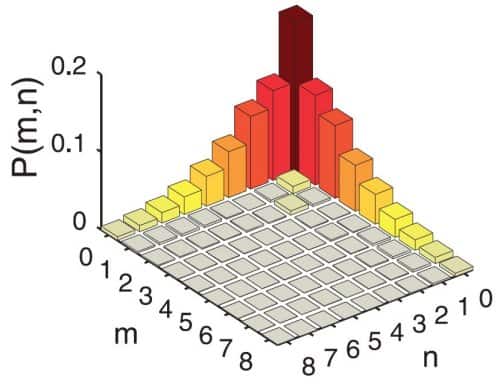
Physicists in Israel are the first to entangle five photons in a NOON state – the superposition of two extreme quantum states. Unlike previous schemes for creating such states, the researchers claim that their new technique can entangle an arbitrarily large number of photons – so called “high-NOON states”. This could be good news for those developing quantum metrology techniques because high-NOON states could be used to improve the precision of a range of different measurements.
In Schrödinger’s famous thought experiment, all of the molecules in a cat are in a superposition of two extreme states – living and dead – and an observer cannot tell which until a measurement puts the cat into one of the two states. Such extreme “Schrödinger’s cat states” can, however, also be made in the lab. Ideally, this could involve splitting a pulse of N photons and sending all N photons down one of two orthogonal paths. The photons would be in a superposition of both paths – called a NOON state after how it is written mathematically.
NOON states are of particular interest in quantum metrology because if the light is recombined in an interferometer, the uncertainty in the resulting measurement scales as 1/N – compared to 1/N1/2 for conventional photon pulses. In other words, the advantage of NOON states is that measurement becomes much less uncertain – compared with conventional light – as the number of photons increases. Furthermore, the diffraction limit for NOON states is 1/N times that of conventional light, which means that such states could improve the resolution of optical microscopes and lithography.
More photons required
Although there is not much to be gained using NOON states when only a few photons are involved, if N is large, they could offer a significant boost to interferometers and other instruments. So far, physicists have been able to create NOON states with up to four photons, but the methods to do so have been complicated and specific to the precise number of photons involved.
Now, however, Itai Afek, Oron Ambar and Yaron Silberberg at the Weizmann Institute of Science have devised a general way of making NOON states – and showed that it works for up to five photons. The catch is that the technique cannot make “perfect” states. The team calculates that it can achieve a fidelity of 92% or better for an arbitrary number of photons. This is not perfect, but good enough for practical applications according to Silberberg.
The team makes its NOON states by firing a conventional laser pulse and a special “quantum pulse” containing entangled photon pairs at a beam splitter. The entangled pairs are created by spontaneous parametric down-conversion (SPDC) whereby a higher energy photon is fired into a special crystal to produce a pair of entangled photons at a lower energy.
Amplitude and phase
The beam splitter has two inputs and two outputs. The NOON states are unique because all N photons choose the same output path. However, the experimentalist cannot know, even in principle, which one.
The two paths are then recombined in a Mach Zehnder interferometer. By measuring the amplitude and the phase of the resulting interference signal, the team determined the degree of entanglement and how many photons are entangled.
For a NOON state with five photons, the team measured a contrast in the interference signal of about 42% –. While this is smaller than the theoretically obtainable value of 92% it is much higher than that expected if the photons were not entangled at all (17%). For two, three and four photon NOON states the contrasts were 95%; 86%; and 74% respectively.
Important experiment
Jeremy O’Brien of the UK’s Bristol University described the work as an important experiment. O’Brien – who helped to develop a method for creating four-photon NOON states – believes that the new technique could also be applied to the microscopy of biological samples that are very sensitive to light. This is because NOON states could deliver the required resolution using far fewer photons than conventional light.
Jonathan Dowling at Louisiana State University also sees microscopy as an important application. He believes that the technique could be used to image live bacteria and viruses using harmless red light – but achieving the same resolution as harmful UV radiation.
Silberberg told physicsworld.com that the team is now looking at how the technique could be adapted for use in microscopy.
Looking even further in the future there is a chance that the technique could come in handy in gravitational wave detectors such as LIGO. These are huge interferometers that have yet to detect gravitational waves and could benefit from further boosts in sensitivity.
However, Roman Schnabel of the Max Planck Institute for Gravitational Physics in Germany argues that it will not be possible to create NOON states with enough photons to compete with the intense pulses used in experiments such as LIGO.
The work is reported in Science 328 879.



